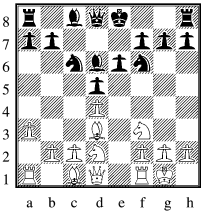
December 2011
Division 3
|
Division 4
|
In division 3 Alsager have dropped a little off the pace after two November defeats, whilst Fenton B still lurk just behind the leaders - a busy Decemeber should tell us more about them. A couple of wins have lifted Newcastle D away from the foot of the table, but there are still no decisive gaps in the table. Despite being the largest division, the third is the only one of the four not to have suffered any postponements.
Division four is beinning to look like a Cheddleton versus Fenton battle, though one mustn't rule out the possibility of one of the Meir sides putting in an extended good run when they have all their players available.
The minor cup for the Perry Trophy is also associated with the lower divisions, and in the only quarter final match Fenton comprehensively beat Holmes Chapel to set up a South Potteries semi-final derby with Meir.
Division 1
|
Division 2
|
The major cup featured a five draw draw between Alsager and Newcastle, which will require a replay to sort.
Postponements: In division one Kings v Stafford was postponed to make room for the previously unplayed Open Cup match betwen Stafford and Alsager, which Alsager then conceded. In division 2 Cheddleton B v Knights was put back by a couple of weeks, but has now been played, whilst division four also suffered its first postponement with Meir C's visit to Cheddleton E requiring a new date. In the major cup Kidsgrove's visit to Fenton was put back three weeks to 5th December.
Just one defaulted board by Alsager C to report.
Sam Onions and Pete Shaw, both Newcastle, lead the activity table with 13 and 12 appearances respectively, with Geoff Yates (Fenton) and Richard Martin and Neville Jones (both Alsager) all on 10. In all 143 players have appeared at least once, of which 42 have at least five games under their belt. Life the universe and everything gets everywhere!
comment on this article
Rightly or wrongly I have tended to regard 140 (old money) as the minimum standard for fringe first division players, 150 for established ones. In new grade terms I round these down to 150 and 160 respectively. I have easy access to local grades for season 2002/3 onwards, making 10 seasons in all. What have we achieved in terms of generating our own first division players in that time?
First I should note that I cannot be completely sure as to which players are our own ie started their competitive chess career in the NSDCL, and which are imports. With apologies to those I have misidentified I think there are just 14 home grown players who first reached fringe division one standard in these ten years:
| name | club | fringe (1) | estab (2) | current/last grade |
| Suzy Blackburn | H Chapel | 2/3 | 3/4 | 169 |
| Steve Bruce | Newcastle | 3/4 | 145 (7/8) | |
| Stephane Pedder | Stafford | 3/4 | 10/11 | 169 |
| John Yee | Cheddleton | 3/4 | 146 | |
| Yangshi Yu | Cheddleton | 5/6 | 6/7 | 151 |
| Richard Lee* | Newcastle | 5/6 | 9/10 | 175 |
| Phil Cattermole | HC/Maccs | 6/7 | 138 | |
| Simon Crowley | Cheddleton | 7/8 | 8/9 | 160 (10/11) |
| Craig Whitfield | Cheddleton | 7/8 | 8/9 | 187 |
| Geoff Lee | Newcastle | 9/10 | 137 | |
| Tim Stevens | Newcastle | 9/10 | 153 (10/11) | |
| Matthew Wyza | Cheddleton | 10/11 | 143 | |
| Vijay Kumar | Macclesfield | 11/12 | 155 | |
| Ken Wozniak | Stafford | 11/12 | 150 |
Chon-Yui Lee (Newcastle) reached established status in season 4/5 (after he left the area), having entered the period with fringe status. His last grade was 171 for season 6/7. Ben Zitha (Fenton/Alsager), now 173, and Daniel Sullivan (Newcastle), latest grade 154 in 7/8, moved here with sub division one status which they have since obtained. Carl Gartside reached fringe status last year, though is perhaps best regarded as a High Peak player who sometimes turns out for Cheddleton, and Denzil Lobo (Macclesfield) reached the same mark this year, but as he rarely features in Macclesfield's Stoke League squad cannot really be regarded as one of North Staffs'. I emphasize not only that some of those listed above may have started elsewhere, but also that there may be others who should be included, particularly amongst those who have left the area.
Maybe I have been a bit of a snob with regards to what I believe the standard of division one players should be, but it seems to me that we are relying heavily on imported players to man our top division - how long would it take at current rates to completely replace our current stock of division one players relying only on our own efforts, let alone a full 8 team divisions worth?
What of the future? Jon Blackburn (Holmes Chapel) John Paul Taylor (Macclesfield) and Molly Moruzzi (ex-Cheddleton) are close. Some of the current crop of Cheddleton juniors show promise, as do Sam Onions (Newcastle) and Ben Scattergood (Holmes Chapel), and Fenton will have their own hopes on behalf of one or two of their recent additions. But is that evidence that the next 10 years will be any more fruitful than the last?
The league of course is about more than division one, and it is easier to find proof that we are coping better at internally renewing the lower divisions, though the shrinkage at Kidsgrove and Meir also shows there is no room for complacency.
Clubs have to tread a compromise line between being for existing members now and looking to the future. Unfortunately it is much easier for a club to accept a recycled player into their ranks than a completely new one, and with junior chess at secondary school level at a low level of activity the supply of (near-)ready made players is unlikely to increase any time soon.
comment on this article

|
| Dave Fuller v RR after 8 0-0 |
We join the game with RR pondering his eighth move. "Why ponder?" you may ask. Castles is near automatic. But you've reckoned without RR being mentally unprepared for this game.
8 ... h5 Concedes g5 to white, asking to be a victim of a kingside attack if he castles short. Castle long and he can now expect c4 to come at a rate of knots, so king in the centre. Is this wise Captain Mainwaring sir?
9 Re1 Where else should a rook go against a central king?
9 ... Ng4, 10 h3 Bd7 A waiting move
11 hxg4 resisting anything except temptation
11 ... hxg4, 12 Ne5 I recommend that you do not play this came out on Fritz - my copy needed psychiatric treatment after seeing this move. There are three ways of responding to being on the receiving end of a proferred sacrifice - decline it, accept and look to return the material, or grab and hold, daring the opponent to prove the sacrifice sound. Choosing the wrong option is rarely good for your health.
12 ... Qh4, 13 Kf1 Nxd4 Not thinking of using e2 as an escape square are you?
14 f4 Qg3, 15 Qxg4 Rh1 That's all folks!
Thankfully Dave has a better sense of humour than the average public sector worker faced by Jeremy Clarkson, so probably won't thump me too hard for my chirpy report.
comment on this article
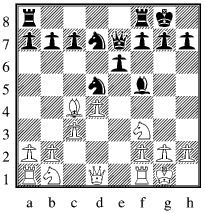
|
| Steve Emmerton v RR after 9 ... Nd7 |
As we join the game RR has gained a small lead in development in the opening, though neither side has any obvious weaknesses. This could be the sort of time in which a lot of time is used up on relatively few moves simply looking for ideas.
10 Bxd5 exd5, 11 Re1 Qd6, 12 Nbd2 Nf6 A poor choice. White is ready to insert a knight into e5 and bring the other to f3 to support it. Should really contest the open file with a rook even if this results in further simplification.
13 Ne5 Rae8, 14 Qf3 Qe6 voluntarily placing his queen on the same file as an enemy rook.
15 h3 Ne4, 16 Qe2 f6, 17 Nd3 Qd7, 18 Nxe4 preventing further growth of pressure
18 ... Rxe4, 19 Qf3
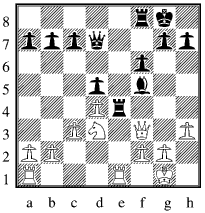
|
| Steve Emmerton v RR after 19 Qf3 |
20 g4 Bg6, 21 Qg3 Re2, 22 Rxe2 Rxe2, 23 Nc5 Qe7 If black doesn't want to take time out from being agressive with Qc6, then Qb5 is a better choice for pressuring white.
24 b4 (24 Nxb7 Rxb2, 25 Nc5 and white has not won a pawn)
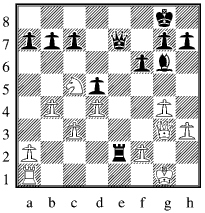
|
| Steve Emmerton v RR after 24 b4 |
25 Nd3 (25 Nxb7 Re1+, 26 Rxe1 Qxe1+, 27 Kg2 Be4+
28 f3 Qe2+, 29 Qf2 Bxf3+, 30 Kg3 Qxf2+, 31 Kxf2 and again white hasn't won a pawn. Black has the bishop against knight, but one more pawn island.)
25 ... Be4, 26 Nf4 Rc2, 27 a4 g5, 28 Nh5 Bg6 Both players are beginning to run short of time, so RR goes for the simple plan of disrupting white's pawns. f5, threatening f4 to take the knight permanently out of the game without giving up the bishop would have been superior.
29 f4 Bxh5, 30 gxh5 Re2, 31 fxg5 fxg5, 32 Qf3 Qe3+ 33 Qxe3 Rxe3 Which pawn should white save?
34 Kg2 (Rc1 and c4 better - white would have some chance of creating counter threats, though in truth with his flag about to fall the choice was academic.)
Rxc3 0-1
comment on this article
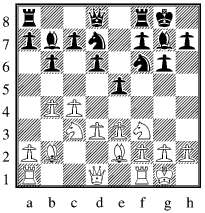
|
| RR v Julian Kirk O'Grady after 9 ... Bb7 |
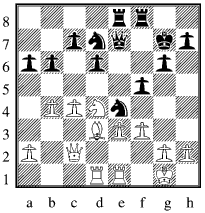
|
| RR v Julian Kirk O'Grady after 18 f3 |
19 e4 Qf6, 20 Nc6 f4, 21 Re2 Nf7, 22 Qb2 Who is better for the queens coming off? I feel the need to contest the long diagonal, but maybe I should keep my queen for other purposes such as supporting further advances of the queenside pawns.
22 ... Nfe5, 23 Nxe5 Rxe5, 24 a4 Considered c5 and Bxa6 but couldn't see the mileage in it. Didn't like a4 as black seems to be comfortable on the queenside after a5. Probably should have settled for a3 as more flexible.
24 ...Nb8, 25 Bb1 a5, 26 Rd5 axb4, 27 Qxb4 Nc6, 28 Qb2 Ree8
29 Qxf6+ Rxf6, 30 Rb2 Ra8, 31 Bc2 Na5, 32 Bd3 Nb7, 33 Bc2 Re6 Wanting to prevent e5. Black's knight appears the superior minor piece, but there seems no obvious way for black to take advantage of this and exert more pressure on the isolated pawns.
34 Kf2 Na5, 35 Rb4 Nc6 If 35 ... c5 then 36 Rxb6 Nxc4 and the game opens up, but to whose advantage?
36 Rb2 Kf6, 37 g3 fxg3+, 38 hxg3 ½ - ½
It is not a good idea for black to try to hold the white pawns back by playing g5.

|
| RR v Julian Kirk O'Grady final position |
RR's space grab on the queenside has enabled him to reach equality.
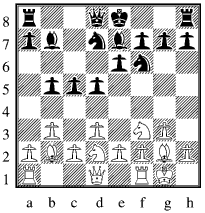
|
| Ken McNulty v RR after 8 ... Nbd7 |
10 dxc4 b4 Both players ignore the bit about capturing towards the centre.
11 Qc2 O-O, 12 e4 Qc7, 13 Rfe1 e5 Already RR is hallucinating on two levels. He didn't want to play e5 because of giving the d5 square to white, and he didn't want to allow e5 for fear of a kingside attack. Yet playing e5 himself secures d4, and there is no significant kingsidde attack after e5 by white. This is going to be a long night.
14 Rad1 a5 15 Nf1 Ra6 Although there are vague thoughts (RR is good at vague thoughts, could do better with concrete ones) of Rd6 and perhaps later doubling on the d-file, the real purpose is to play on the a-file, so why not a4 immediately? - white cannot hold the pawn even if he takes it.
16 N3d2 a4 17 Ne3 Rfa8 18 Nd5
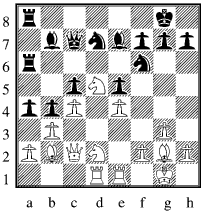
|
| Ken McNulty v RR after 18 Nd5 |
19 exd5 axb3, 20 axb3 Bd6, 21 Ne4 f6, 22 h4 Nf8, 23 Bh3 Qe7 A fatuous move. Black clearly needs to face the bishops so do it now. The game move merely served to place her majesty in danger.
24 h5 Bc8, 25 Bxc8 Rxc8, 26 Ra1 Rb6 Never did get around to putting a rook on a2. Now RR concedes the a-file without a fight.
27 Nxd6 Rxd6, 28 f4 Nd7, 29 Ra7 Qe8, 30 Qf5
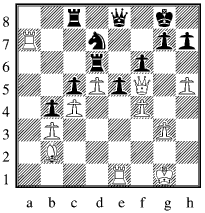
|
| Ken McNulty v RR after 30 Qf5 |
30 ... g6, 31 hxg6 hxg6, 32 Qh3 For want of something better to do RR kicks the queen away, but all this achieves is to create options for white down the h-file to go with his other attacking lines.
32 ... Ra8, 33 Rxa8 Qxa8, 34 Re2 fxe5 immediately looks more natural
34 ... Qa2, 35 fxe5 To be consistent this capture needs to be delayed a further move in order to protect the rook first. (Rh2 and black further reduces pressure with Qb1+)
35 ... fxe5, 36 Bxe5 Qxe2, 37 Qh8+ Bxd6 leaves white a clear pawn ahead with his queen ready to repulse black checks.
37 ... Kf7, 38 Qg7+ Ke8, 39 Qg8+ Ke7, 40 Bxd6+ Kxd6
41 Qxg6+ Kc7, 42 Qc6+ Kd8, 43 d6
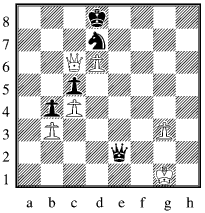
|
| Ken McNulty v RR after 43 d6 |
43 ... Qd1+, 44 Kf2 Qc2+, 45 Kg1 Qd1+, 46 Kf2 Qd2+, 47 Kf1 Qd3+, 48 Kg2 Qf5
49 Qa8+ Disaster! So fixated with Qc7+, I overlooked this completely. My earlier thoughts should have been to protect the c-pawn with the queen, and move the knight. This requires the queen on e3 to also protect against checks on e7, and Nf6. Easy with hindsight.
49 ... Nb8 the only move
50 Qxb8+ Qc8 50 ... Kd7, 51 Qc7+ Ke6, 52 Qe7#
51 Qxc8+ Kxc8, 52 Kf3 Kd7, 53 Kf4 Kxd6, 54 Kg5
Kf5 and it would have taken masochistic tendencies to play on. Here at least I have the pleasure of eating his queenside pawns before the g-pawn queens. So what? Well Ken is very short of time. Maybe he'll sue for peace. Except we're playing Fischer. Maybe I can sneak my c-pawn to the seventh and get a draw that way, though it would help if the queenside pawns were arrowed the other way. Perhaps I can get my b-pawn to the seventh, and then sneak it to the eighth as he tries to avoid repetition. Yes, show me a straw and I will clutch it.
So we played on, and on move 71 as he checked the latter stages of his plan to conclude the game with my b-pawn on the seventh, Ken's flag fell.
What is it with these Stafford players? Through a combination of my ineptitude and their decent play they put my king in jail. However they fail to turn the key in the lock, so like all the best comic book heroes with one bound I leap free.
A footnote, especially for any younger readers. At no point in the latter stages of the game did I even contemplate offering a draw myself. Yes, he was short of time, and needed to take care to avoid repetitions. But to my mind any such draw offer would be frivolous and so count as distraction, which is NOT allowed. Ken would be perfectly capable of deciding for himself if he was willing to take a draw at any point and so offer it himself.
comment on this article

RR v George Scattergood after 6 ... c6 (left), 14 fxe5 (centre), 29 ... f3 (right)
rnb1kb1r/pp3ppp/2p5/3qp3/8/3P1Q2/PPP2PPP/R1B1KBNR w
1bkr3r/pp1n1ppp/4b3/1Np1P3/8/3PB3/PPP2PBP/R3K2R b
1kr2r2/3b3p/p1PP4/1p4p1/nP1R4/P4p2/2RB1PBP/2K5 w
7 Ne2 Not the sort of temptation I resist. Isolated pawns coming up
7 ... Qxf3, 8 gxf3
RR now defends casually against a touring knight. Oh look, I'm losing a pawn. Which shall it be? I know, I'll pull his e-pawn across to d6. It won't be able to live long there.
14 ... a6, 15 Nd6+ Bxd6, 16 exd6
Rejoining ready for move 30 we see that the prediction about the life expectancy of the d6 pawn is wide of the mark. George now elects to keep the bishops on with c7+.
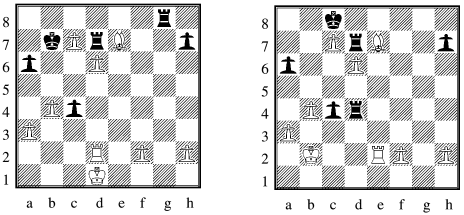
RR v George Scattergood after 42 Be7 (left), 49 Re2 (right)
6r1/1kPrB2p/p2P4/8/1Pp5/P7/3R1P1P/3K4 b
2k5/2PrB2p/p2P4/8/1Ppr4/P7/1K2RP1P/8/ b
Objectively best must be to take the d-pawn and see whether the rook ending is salvageable. However I feel that George has the urge to play a bishop move with Re8+ (big ouch) to follow, so the game continues
49 ... Rf4, 50 Bg5 Rf8, 51 Kc3 seeing the chance to mop up another pawn.
51 ... Rxd6 (at last!), 52 Be7 a fork
But with a choice of checks for black, or the pin Re8, the fork doesn't work.
More moves get played until ...
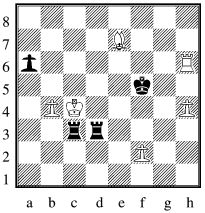
Final position RR v George Scattergood